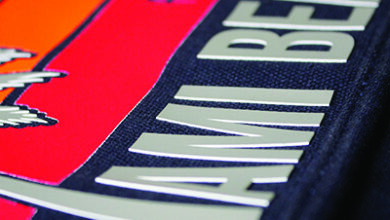A typical challenge in sublimation is pressing two-sided products. Aluminum parts can have both sides pressed simultaneously. However, some substrates, like hardboard, medium-density fiberboard, and fiberglass reinforced plastics, should only be pressed one side at a time due to the difference in heat distribution and its effect on the sublimated image.
It is possible to use a jig to press thin, double-sided hardboard. However, most of the time, jigs are used to sublimate one side at a time using two printed transfers for multiple parts. Small double-sided items are the ideal size for pressing two sides at a time. Larger pieces, like metal prints, should be pressed one side at a time. More time and care will yield great results.
Pro tips for sublimating two-sided aluminum products (pressing both sides at the same time):
- It is a good idea the first time you sublimate a double-sided item to use a blank to test. You want to see how your color appears on both sides of your product and make sure your transfers are correctly aligned.
- First, grab scissors, heat tape, heat gloves, a lint-free cleaning cloth, an all-purpose cleaner, and blowout paper for your heat press.
- Clean both sides of your product well to remove any dust, fingerprints, and lint.
- You should have two image transfers, one for each side. Trim the corners about ¼” away (about 6 mm) from the edge of one of the transfers, so you have plenty of space to tape the first transfer to the second.
- Next, line up and center one side of the blank product on the transfer with the trimmed edges. When lined up, crease the edges of the trimmed transfer around the blank, so it’s outlined with the transfer paper. The blank will need to stay lined up with the outline of the image.
- Position the second non-trimmed transfer face up (with the image facing you) close to the edge of your work surface. Carefully place the trimmed transfer on top of the second transfer, so the image matches up. You can lift the edge of the trimmed transfer to help place it. Double-check the line up before taping the transfer.
- When taping the transfer, make sure you only put heat tape on the design edges, not on the product’s outline. You are essentially making a pocket for your product while trying to keep it lined up between your two transfers, so you need to tape at the four edges of the transfer paper. Do not cover up any side or edge of the blank with tape, or it will leave a faint line where the ink can’t transfer in the press.
- After taping, move or slide the taped transfers from your workspace without shifting the blank inside it, and place it in your heat press. Place blowout paper over the top of the product to prevent moisture issues when sublimating. Sublimate your product at the recommended time and temperature.
- When done pressing, let the product sit for a moment, remove the blowout paper, and use heat gloves to tear off the transfer papers and tape. Lay the product on a flat surface to cool completely.
If you can press one-sided material with perfect quality, you can easily add two-sided products to your lineup. Follow these tips to create high quality sublimated products in less time. As your pressing skills improve, you may even develop your own methods to speed up your production time without sacrificing quality.




